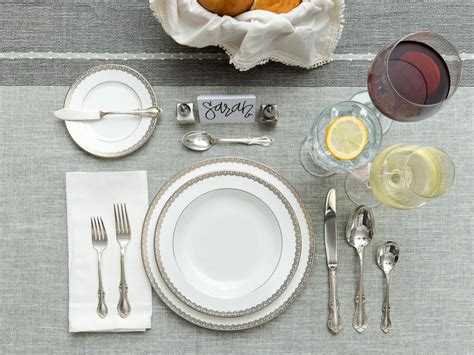How To Set a Table: A Guide to Effortless Elegance
Setting a table might seem simple, but mastering the art can elevate any meal, from a casual weeknight dinner to a formal holiday feast. This guide will walk you through the basics, covering everything from casual place settings to more formal arrangements. We'll cover different styles and offer tips to make your table setting shine.
Understanding Basic Table Setting Etiquette
Before diving into specifics, let's establish the fundamental principles of table setting. The key is to create a functional and aesthetically pleasing arrangement that considers both comfort and etiquette. Remember, the goal is to make your guests feel welcome and comfortable.
The Core Elements:
- Dinner Plate: The foundation of your setting. Positioned in the center of each place setting.
- Dinner Fork: Placed to the left of the dinner plate.
- Dinner Knife: Placed to the right of the dinner plate, blade facing the plate.
- Dinner Spoon: Placed to the right of the knife.
Casual Table Setting: Everyday Elegance
For everyday meals, a casual setting is perfectly acceptable. This approach focuses on practicality and comfort.
Essential Components for a Casual Setting:
- Dinner Plate: As mentioned above, this forms the base.
- Fork & Knife: Only include the utensils you'll actually need.
- Napkin: Folded neatly to the left of the fork, or on the dinner plate.
- Glasses: One water glass is sufficient for casual meals. Place it above and slightly to the right of the knife.
Tip: Choose simple, everyday tableware. Mismatched plates and silverware can add a charming, rustic touch.
Formal Table Setting: Impressing Your Guests
Formal settings require a more detailed approach, reflecting a higher level of sophistication and attention to detail.
Elements of a Formal Table Setting:
- Charger Plate: A large decorative plate placed underneath the dinner plate. Removed before the main course.
- Salad Fork: Placed to the left of the dinner fork.
- Salad Plate: Smaller plate positioned to the left of the forks.
- Soup Spoon: Placed to the right of the dinner spoon, if soup is served.
- Bread Plate & Butter Knife: Placed to the upper left of the forks. The butter knife is placed across the bread plate.
- Water Glass: Above and slightly to the right of the knife.
- Wine Glasses: Typically two, one for red wine (larger bowl) and one for white wine (smaller bowl), arranged to the right of the water glass.
- Napkin: Folded neatly on the dinner plate or to the left of the forks.
Tip: Use your finest china, silverware, and linens for a truly elegant presentation. Pay attention to the placement of each item to create a balanced and harmonious look.
Beyond the Basics: Adding Personal Touches
Once you've mastered the fundamental settings, you can add personal touches to make your table truly unique.
Creative Additions:
- Centerpieces: Flowers, candles, or other decorative items can enhance the ambiance.
- Place Cards: Add a personalized touch for formal events.
- Favors: Small gifts for your guests add a special touch.
- Linens: Tablecloths and napkins can greatly impact the overall aesthetic. Choose colors and patterns that complement your style.
Tip: Don't be afraid to experiment! Let your creativity guide you as you personalize your table setting.
Conclusion: Mastering the Art of Table Setting
Setting a table is more than just arranging utensils; it's about creating an inviting atmosphere for your guests. By following these guidelines and incorporating your personal style, you can transform any meal into a memorable experience. Now, go forth and impress!
